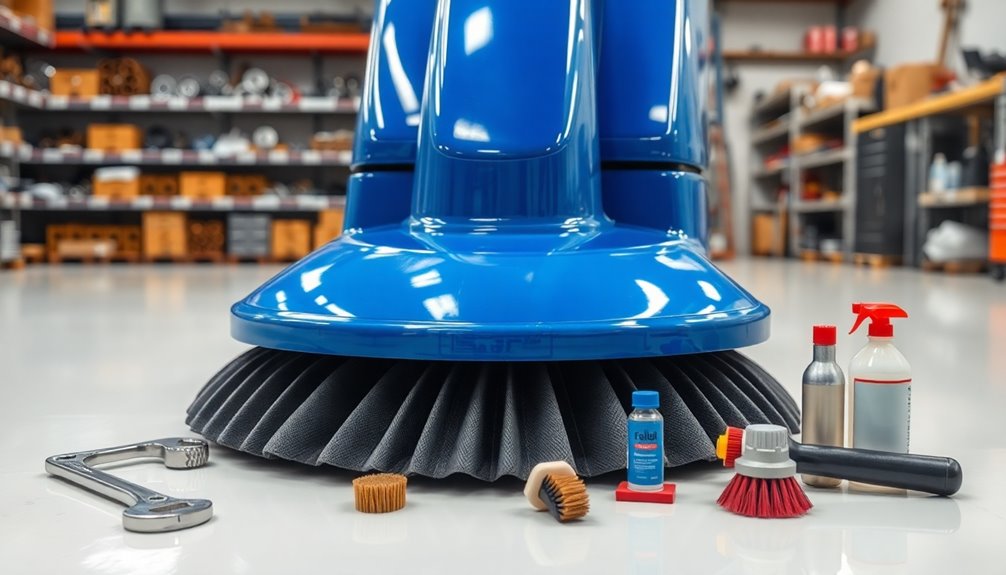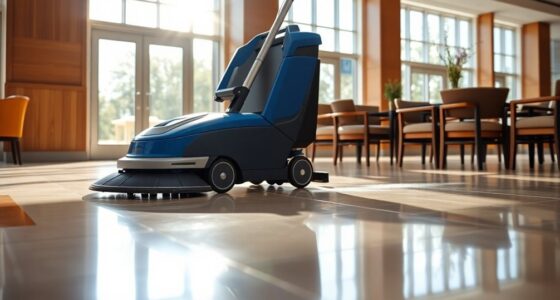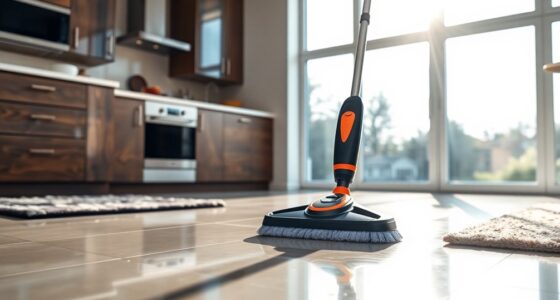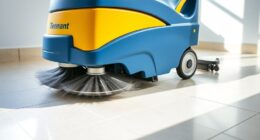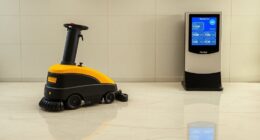To extend your floor scrubber's life, follow this essential maintenance checklist: regularly inspect and clean battery terminals, hoses, and tanks. Choose the right pads, brushes, and cleaning chemicals for your floors. Keep batteries charged and stored properly to enhance lifespan. Prevent residue buildup by draining tanks and keeping debris trays clean. Lastly, perform routine checks and adjustments weekly and monthly. Keep an eye out for more tips to optimize your scrubber's performance.
Key Takeaways
- Regularly check and clean battery terminals to prevent corrosion and ensure secure connections for optimal performance.
- Inspect pads, brushes, and squeegees frequently, replacing or cleaning them to maintain effective cleaning efficiency.
- Drain and rinse solution and recovery tanks daily to prevent residue buildup and ensure proper operation.
- Pre-sweep floors before scrubbing to remove debris, reducing the risk of clogs and damage.
- Conduct monthly inspections for leaks and flush the solution system to maintain scrubber condition and functionality.
Regular Inspection and Cleaning Practices
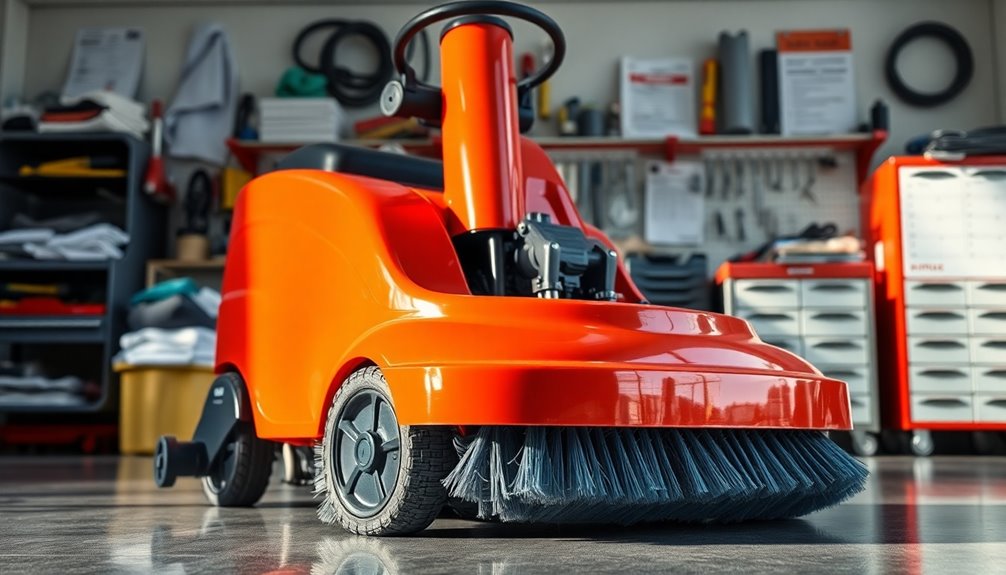
To keep your floor scrubber running efficiently, it's essential to incorporate regular inspection and cleaning practices into your routine.
Start by checking the battery terminals for corrosion and ensuring connections are secure. Inspect hoses for cracks and filters for blockages to prevent clogs. Regularly inspect battery performance to ensure optimal function.
Don't forget to clean the debris tray after each use to avoid dirt buildup. Regularly assess the machine for signs of wear, addressing any issues promptly.
Daily, empty and rinse the solution and recovery tanks, and clean squeegees to maintain effective water pickup. Wipe down the exterior and thoroughly clean brushes and pads.
Lastly, prepare floors by sweeping or dry mopping before scrubbing to optimize performance. These steps will help extend your scrubber's life.
Proper Pad/Brush and Chemical Selection

Regular inspection and cleaning practices set the foundation for your floor scrubber's performance, but using the right pads, brushes, and chemicals takes it a step further. Choose pads based on your floor type—like concrete or marble—and match their color to the cleaning task. For everyday cleaning, blue or green pads work well, while red or pink pads are better for buffing. When selecting brushes, consider the bristle material and hardness; softer bristles suit delicate surfaces, while harder ones tackle deep grime. Always ensure your chemicals are compatible with your floors and follow manufacturer guidelines. Additionally, proper pad/brush selection significantly enhances cleaning results and overall scrubber efficiency.
Battery Care and Management
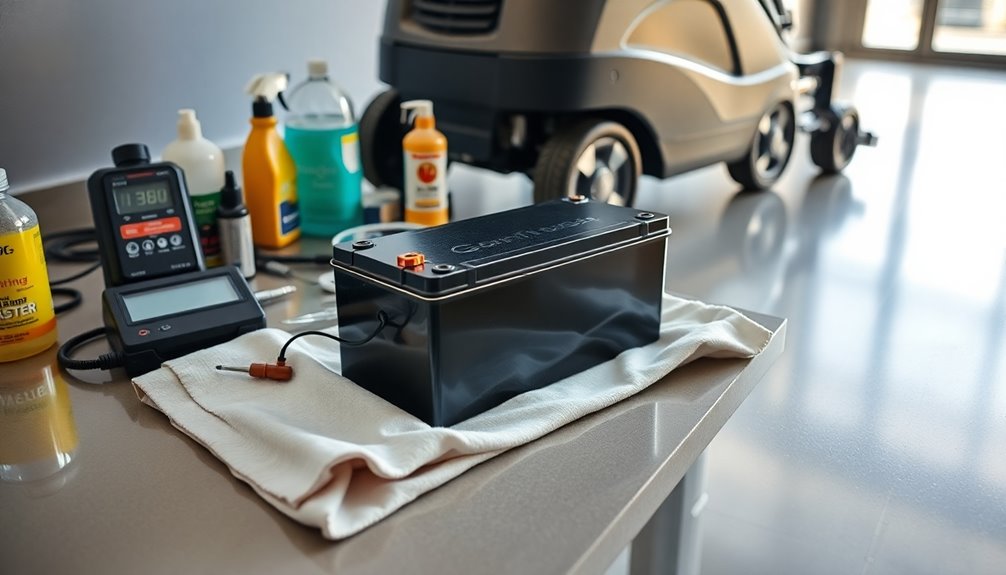
Battery care and management is crucial for maximizing the performance and longevity of your floor scrubber.
Always ensure your batteries are fully charged before each use to enhance runtime. Avoid overcharging; it weakens battery cells and shortens lifespan. Charge immediately after use, and steer clear of leaving them partially charged, as this can negatively impact longevity. Regular maintenance of cleaning machines is vital for ensuring efficient battery performance. Additionally, monitoring your battery's performance indicators can help you determine when maintenance is needed.
Regularly inspect battery terminals for corrosion and ensure connections are secure. For wet flooded batteries, check water levels weekly and top off with distilled water to prevent corrosion.
Store batteries in a cool, dry place to extend their life. If you notice deterioration, replace old batteries promptly to maintain performance and efficiency.
Preventing Residue Buildup and Clogging
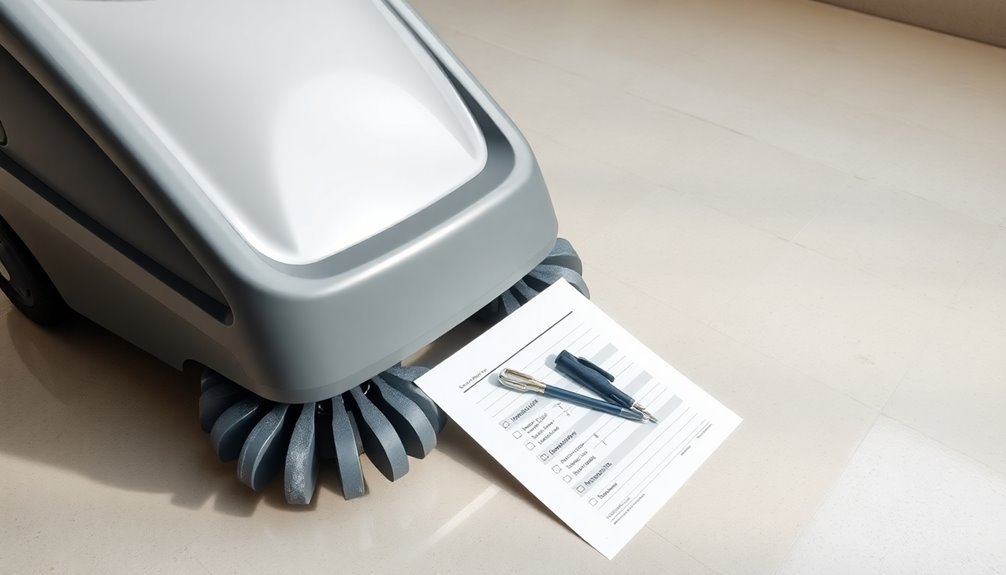
While using a floor scrubber can effectively clean your floors, it's essential to prevent residue buildup and clogging to maintain its performance.
Start by draining and rinsing both the solution and recovery tanks after every use. Always choose appropriate cleaning solutions for your floor type, and adjust the solution flow to avoid oversaturation. Regular maintenance of the tanks ensures smooth operation and contributes to overall cleaning efficiency.
Using too much cleaning solution can lead to residue that attracts dirt. Pre-sweep floors to remove debris that could cause clogs, and regularly inspect and clean hoses.
Check the squeegee for damage, ensuring it's suitable for the surface. Finally, keep debris trays clean to prevent accumulation.
These steps will help you avoid residue and clogging issues, extending the life of your scrubber.
Routine Maintenance Tasks
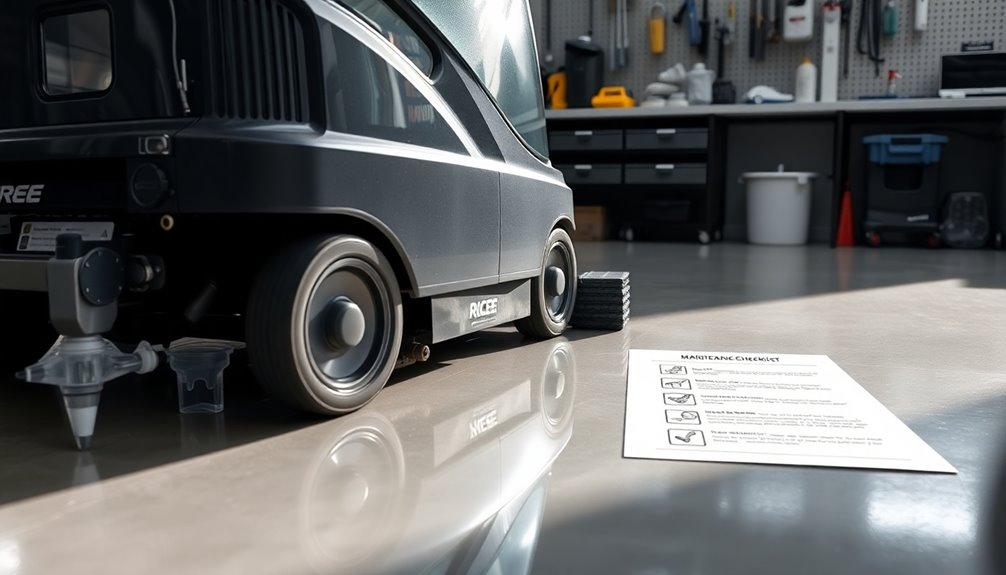
To keep your floor scrubber running smoothly, it's crucial to establish a routine maintenance schedule. Start with daily tasks like checking battery levels and cleaning pads, brushes, and squeegees after each use. Don't forget to drain and rinse the solution and recovery tanks to prevent corrosion, and inspect the machine for any loose or damaged parts. Proper training equips operators to perform maintenance effectively and identify potential issues.
On a weekly basis, inspect battery terminals for corrosion, adjust brush pressure, and check drive belts for wear. Lubricate moving parts as recommended and assess squeegee condition. Monthly, perform a full equipment assessment, check for leaks, and flush the solution system with hot water and detergent.
Finally, clean and deodorize tanks to keep your scrubber in top shape.
Utilizing Maintenance Software and Training

Utilizing maintenance software and training can significantly enhance the efficiency and lifespan of your floor scrubber.
With real-time data tracking, you can spot potential issues early, preventing costly repairs. Scheduling maintenance tasks becomes a breeze, reducing downtime and ensuring your scrubber is always ready for action. Customizable software fits your specific needs, while comprehensive reports guide your decision-making. Implementing these strategies also ensures clean and dry floors after each use, contributing to a healthier environment.
Training your staff is equally important. It boosts efficiency, minimizes downtime, and improves safety, leading to cost savings. Hands-on sessions and theoretical knowledge provide your team with the skills to maintain the scrubber effectively.
Integrating software with training allows for automated reminders and performance monitoring, ensuring continuous improvement and optimal operation of your equipment.
Frequently Asked Questions
How Often Should I Replace My Floor Scrubber's Pads or Brushes?
You should replace your floor scrubber's pads or brushes based on their wear and effectiveness.
If pads are less than 10mm thick or require more passes to clean, it's time for a change.
For brushes, check wear indicators or replace cylindrical brushes when bristles are worn to ½ inch.
Regularly inspect and clean them to maximize their lifespan.
The frequency will depend on your cleaning routine, floor type, and soil conditions.
What Are the Signs of a Failing Battery in My Floor Scrubber?
Ever wondered why your floor scrubber isn't performing as it used to? Signs of a failing battery include reduced runtime, inconsistent performance, and noticeable voltage drops under load.
You might also spot visible corrosion on terminals or notice that the battery's age exceeds five years. Regular checks can help, so keep an eye out for these indicators.
If you see any, it's time to troubleshoot or consider replacements!
Can I Use Homemade Cleaning Solutions With My Floor Scrubber?
You can use homemade cleaning solutions with your floor scrubber, but be cautious.
Make sure the ingredients are compatible with your machine and the floor type. Test the solution on a small area first to avoid damage.
Remember, homemade mixes mightn't clean as effectively as commercial products and could lead to clogging.
Regular maintenance of your scrubber is essential if you choose this route to prevent potential issues down the line.
What Safety Precautions Should I Take While Operating a Floor Scrubber?
When operating your floor scrubber, prioritize safety with a careful, conscious approach.
Clear the surroundings of clutter and consider using caution signs to alert nearby pedestrians.
You should wear proper personal protective equipment (PPE) like safety shoes and eye protection.
Always inspect your scrubber for damage before use and maintain controlled speeds during operation.
Smooth turns are essential; avoid sharp maneuvers to prevent accidents.
How Can I Tell if My Floor Scrubber Needs Professional Servicing?
You can tell your floor scrubber needs professional servicing by watching for certain signs.
If it's not cleaning effectively or if you notice reduced battery performance, those are red flags.
Check for leaks, unusual noises, or persistent odors, too.
If you're facing stubborn clogs or worn components that can't be easily replaced, don't hesitate to call in the pros.
Addressing these issues early can save you time and money in the long run.
Conclusion
In the grand symphony of floor care, your scrubber's maintenance is the conductor that ensures a harmonious performance. By embracing these essential practices, you're not just prolonging the life of your machine; you're investing in a cleaner, safer space. Think of it as nurturing a delicate plant—consistent care leads to flourishing results. So, roll up your sleeves, tune into those maintenance rhythms, and watch your floor scrubber shine for years to come!
